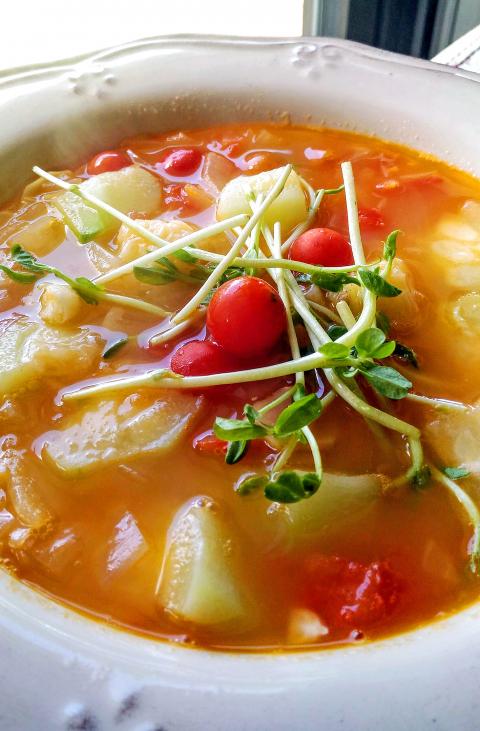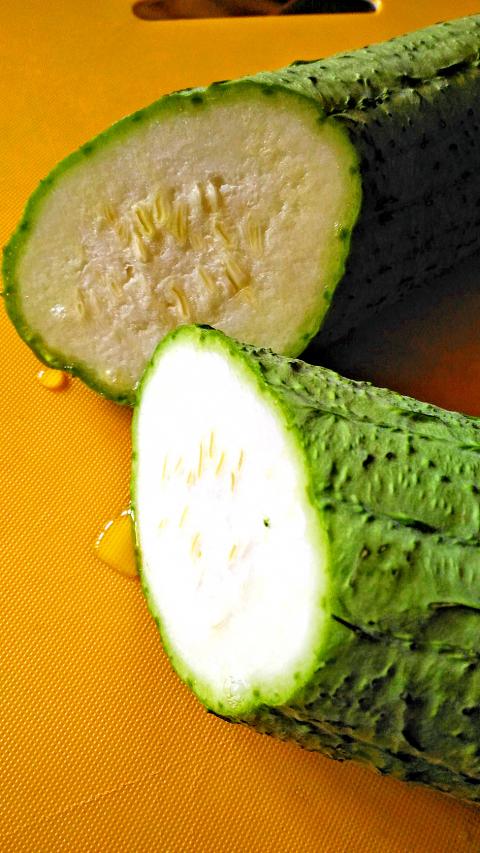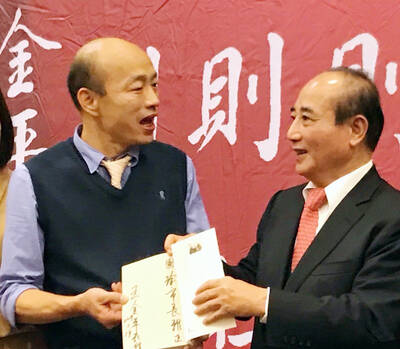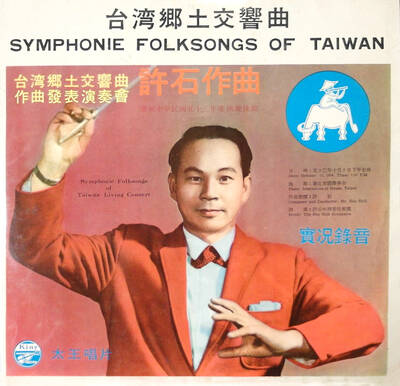Loofa (絲瓜) goes by many names and is probably best known in the west as the source of a natural sponge for use in bathing. In this incarnation it is commonly marketed as the “loofah,” the additional silent “h” in this context being added for reasons unknown. In Asia, it is widely appreciated as a highly nutritious vegetable that thrives during the hot summer months, but its lack of versatility in the kitchen has limited its appeal.
The loofa comes in two forms, one often called the ridged or angled gourd, a reference to the distinctive 10 ridges along its length. In Taiwan, this version is often regarded as a specialty of the Penghu archipelago, and while they are not exclusively grown there, they are most often simply called Penghu loofa (澎湖絲瓜). The more ubiquitous version has a tube-like appearance and is often called sponge gourd. It has a wider body than the ridged loofa and is the typed most often used in the manufacture of the bath sponge.
The Penghu loofa is prized for its firmer flesh, and this quality can really shine when used in a properly composed stir fry. Both ridged and smooth loofa can quickly be reduced to a horrendous-looking mush if not handled correctly. As this really does not go much beyond a careful eye on heat and cooking time, it is surprising how often loofa gets served up as unappealing slop even at quite good restaurants.

Photo: Ian Bartholomew
The flavor of the loofa is very delicate and is not at all easy to describe, balancing along a knife edge of bland sweetness with a hint of acrid sliminess that is best appreciated in loofa juice, a concoction to which Chinese medical lore attributes huge medical benefits, but in my view is a strong contender for the most vile vegetable health drink yet conceived — right up there with asparagus juice and Chinese mesona (仙草).
When cooked, its flavor can be quite pleasant, and in Taiwan it is often served together with clams, a combination that works remarkably well. The clams get to show off their full flavor with minimal interference from the accompanying vegetable, and the loofa enriches the broth with its sweetness.
In Southeast Asia, a common combination is to fry loofa together with egg, a dish which achieves a similar quality to that of Taiwan’s home cooking standard of fried egg and tomato (番茄炒蛋). Dishes such as this pack a huge nutritional punch, make a tasty meal with nothing more than the addition of white rice and have the advantage of being quick to make with cheap and easily available ingredients.

Photo: Ian Bartholomew
Loofa is widely used in India, but outside the subcontinent, all that is left after the stir fry is its incorporation into a quick loofa soup (see below). That said, its use within folk medicine is extensive. Primarily, it is widely lauded for its skin cleansing properties, with loofa sap earning the moniker of “water of beauty” (美人水). As a member of the cucurbits family and a relative of the cucumber and watermelon, it is no surprise that the loofa is also lauded as a “cooling” food, soothing the effects of Taiwan’s torrid summer and mitigating all manner of heat rashes and itchy fungal growth. Mitigating menstrual tension and facilitating lactation are also among its many benefits. Loofa is an excellent anti-inflammatory, so inevitably it is also said to be effective with everything from sore throats to cancer.
As with so many of these hardy vegetables, the list of health benefits goes on and on, and the only problem with loofa is finding ways to make it sufficiently varied to eat on a regular basis.
The loofa that we eat is the immature plant, and allowed to mature and dry out, what emerges is a network of xylem fibers that are a wonderful natural sponge. While they are marketed primarily for bathing and skin care in fancy skincare shops, their wide availability and relatively low cost in Taiwan means that they can be used in the kitchen as well. I have found them more effective even than expensive brand-name dish cleaning sponges and scourers, staying grease-free even when handling messy washing up. Just cut off a section from the long loofa and get washing.
So enjoy the plentiful supply of loofa at the moment, and if you get tired of eating them, you can always wait a bit until the plant matures and then use them to exfoliate in a completely natural way. What more could you ask of a vegetable?
Loofa soup
(Serves 2)
Loofa benefits from quick preparation and this one-pot wonder couldn’t be faster to throw together for a quick and remarkably satisfying light meal. You don’t even need stock for this soup, with water providing a more neutral canvas for the flavors of the loofa and tomatoes, which in turn give the liquid a creamy thickness. Use a light touch with the ginger and other seasonings and let the two main ingredients speak for themselves.
Ingredients:
1 large loofa
Handful of cherry tomatoes, halved
Half an onion, finely chopped
A tiny nub of ginger, sliced thinly
1 clove garlic, mashed
1tsp sesame oil
1tsp olive oil
300ml of water
Pinch of white pepper
Pinch of salt
Pea seedlings (豌豆苗), optional
Preparation:
1. Cut away the skin of the loofa with a sharp knife then cut the flesh into equal bite-sized pieces.
2. Add the sesame oil and olive oil to a pot and warm. Add the onion and cook over medium heat until translucent.
3. Add the garlic and cherry tomatoes. Cook for a further 1 minute.
4. Add the thinly sliced ginger and loofa. Mix and cook for 1 minute then add water.
5. Bring to a boil and cook for a couple of minutes. The loofa should still retain its shape.
6. Serve immediately with a topping of pea seedlings.
Ian Bartholomew runs Ian’s Table, a small guesthouse in Hualien. He has lived in Taiwan for many years writing about the food scene and has decided that until you look at farming, you know nothing about the food you eat. He can be contacted at Hualien202@gmail.com.

The depressing numbers continue to pile up, like casualty lists after a lost battle. This week, after the government announced the 19th straight month of population decline, the Ministry of the Interior said that Taiwan is expected to lose 6.67 million workers in two waves of retirement over the next 15 years. According to the Ministry of Labor (MOL), Taiwan has a workforce of 11.6 million (as of July). The over-15 population was 20.244 million last year. EARLY RETIREMENT Early retirement is going to make these waves a tsunami. According to the Directorate General of Budget Accounting and Statistics (DGBAS), the

Many will be surprised to discover that the electoral voting numbers in recent elections do not entirely line up with what the actual voting results show. Swing voters decide elections, but in recent elections, the results offer a different and surprisingly consistent message. And there is one overarching theme: a very democratic preference for balance. SOME CAVEATS Putting a number on the number of swing voters is surprisingly slippery. Because swing voters favor different parties depending on the type of election, it is hard to separate die-hard voters leaning towards one party or the other. Complicating matters is that some voters are

Sept 22 to Sept 28 Hsu Hsih (許石) never forgot the international student gathering he attended in Japan, where participants were asked to sing a folk song from their homeland. When it came to the Taiwanese students, they looked at each other, unable to recall a single tune. Taiwan doesn’t have folk songs, they said. Their classmates were incredulous: “How can that be? How can a place have no folk songs?” The experience deeply embarrassed Hsu, who was studying music. After returning to Taiwan in 1946, he set out to collect the island’s forgotten tunes, from Hoklo (Taiwanese) epics to operatic

Five years ago, on the verge of the first COVID lockdown, I wrote an article asking what seemed to be an extremely niche question: why do some people invert their controls when playing 3D games? A majority of players push down on the controller to make their onscreen character look down, and up to make them look up. But there is a sizable minority who do the opposite, controlling their avatars like a pilot controls a plane, pulling back to go up. For most modern games, this requires going into the settings and reconfiguring the default controls. Why do they